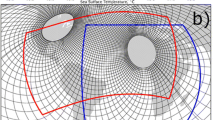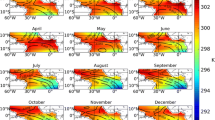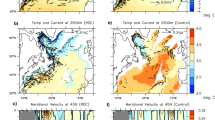Abstract
We investigate the quality of simulating tropical Atlantic (TA) sector climatology and interannual variability in integrations of the Kiel climate model (KCM) with varying atmosphere model resolution. The ocean model resolution is kept fixed. A reasonable simulation of TA sector annual-mean climate, seasonal cycle and interannual variability can only be achieved at sufficiently high horizontal and vertical atmospheric resolution. Two major reasons for the improvements are identified. First, the western equatorial Atlantic westerly surface wind bias in spring can be largely eliminated, which is explained by a better representation of meridional and especially vertical zonal momentum transport. The enhanced atmospheric circulation along the equator in turn greatly improves the thermal structure of the upper equatorial Atlantic with much reduced warm sea surface temperature (SST) biases. Second, the coastline in the southeastern TA and steep orography are better resolved at high resolution, which improves wind structure and in turn reduces warm SST biases in the Benguela upwelling region. The strongly diminished wind and SST biases at high atmosphere model resolution allow for a more realistic latitudinal position of the intertropical convergence zone. Resulting stronger cross-equatorial winds, in conjunction with a shallower thermocline, enable a rapid cold tongue development in the eastern TA in boreal spring. This enables simulation of realistic interannual SST variability and its seasonal phase locking in the KCM, which primarily is the result of a stronger thermocline feedback. Our findings suggest that enhanced atmospheric resolution, both vertical and horizontal, could be a key to achieving more realistic simulation of TA climatology and interannual variability in climate models.


















Similar content being viewed by others
References
Adler RF, Huffman GJ, Chang A et al (2003) The version-2 global precipitation climatology project (gpcp) monthly precipitation analysis (1979–present). J Hydrometeorol 4:1147–1167. doi:10.1175/1525-7541(2003)004<1147:TVGPCP>2.0.CO;2
Ashfaq M, Skinner CB, Diffenbaugh NS (2011) Influence of SST biases on future climate change projections. Clim Dyn 36:1303–1319. doi:10.1007/s00382-010-0875-2
Bachèlery M-L, Illig S, Dadou I (2015) Interannual variability in the South-East Atlantic Ocean, focusing on the Benguela upwelling system: remote versus local forcing. J Geophys Res Ocean. doi:10.1002/2015JC011168
Bellomo K, Clement AC, Mauritsen T et al (2015) The influence of cloud feedbacks on equatorial atlantic variability. J Clim 28:2725–2744. doi:10.1175/JCLI-D-14-00495.1
Biasutti M, Sobel AH, Kushnir Y (2006) AGCM precipitation biases in the tropical Atlantic. J Clim 19:935–958. doi:10.1175/JCLI3673.1
Brandt P, Funk A, Hormann V et al (2011) Interannual atmospheric variability forced by the deep equatorial Atlantic Ocean. Nature 473:497–500. doi:10.1038/nature10013
Breugem W-P, Hazeleger W, Haarsma RJ (2006) Multimodel study of tropical Atlantic variability and change. Geophys Res Lett 33:1–5. doi:10.1029/2006GL027831
Caniaux G, Giordani H, Redelsperger J-L et al (2011) Coupling between the Atlantic cold tongue and the West African monsoon in boreal spring and summer. J Geophys Res 116:C04003. doi:10.1029/2010JC006570
Carton JA, Giese BS (2008) A reanalysis of ocean climate using simple ocean data assimilation (SODA). Mon Weather Rev 136:2999–3017. doi:10.1175/2007MWR1978.1
Chang P, Yamagata T, Schopf P et al (2006) Climate fluctuations of tropical coupled systems—the role of ocean dynamics. J Clim 19:5122–5174. doi:10.1175/JCLI3903.1
Chang C-Y, Carton J a., Grodsky S a., Nigam S (2007) Seasonal climate of the tropical Atlantic sector in the NCAR community climate system model 3: error structure and probable causes of errors. J Clim 20:1053–1070. doi:10.1175/JCLI4047.1
Chang C-Y, Nigam S, Carton J a (2008) Origin of the springtime westerly bias in equatorial atlantic surface winds in the community atmosphere model version 3 (CAM3) simulation. J Clim 21:4766–4778. doi:10.1175/2008JCLI2138.1
Compo GP, Whitaker JS, Sardeshmukh PD et al (2011) The Twentieth century reanalysis project. Q J R Meteorol Soc 137:1–28. doi:10.1002/qj.776
Davey M, Huddleston M, Sperber K et al (2002) STOIC: a study of coupled model climatology and variability in tropical ocean regions. Clim Dyn 18:403–420. doi:10.1007/s00382-001-0188-6
Dee DP, Uppala SM, Simmons AJ et al (2011) The ERA-Interim reanalysis: configuration and performance of the data assimilation system. Q J R Meteorol Soc 137:553–597. doi:10.1002/qj.828
Delworth TL, Rosati A, Anderson W et al (2012) Simulated climate and climate change in the GFDL CM2.5 high-resolution coupled climate model. J Clim 25:2755–2781. doi:10.1175/JCLI-D-11-00316.1
Deppenmeier A-L, Haarsma RJ, Hazeleger W (2016) The Bjerknes feedback in the tropical Atlantic in CMIP5 models. Clim Dyn 47:2691–2707. doi:10.1007/s00382-016-2992-z
Deser C, Capotondi A, Saravanan R, Phillips AS (2006) Tropical pacific and Atlantic climate variability in CCSM3. J Clim 19:2451–2481. doi:10.1175/JCLI3759.1
DeWitt DG (2005) Diagnosis of the tropical Atlantic near-equatorial SST bias in a directly coupled atmosphere-ocean general circulation model. Geophys Res Lett 32:1–4. doi:10.1029/2004GL021707
Ding H, Greatbatch RJ, Latif M, Park W (2015a) The impact of sea surface temperature bias on equatorial Atlantic interannual variability in partially coupled model experiments. Geophys Res Lett 42:5540–5546. doi:10.1002/2015GL064799
Ding H, Keenlyside N, Latif M et al (2015b) The impact of mean state errors on equatorial Atlantic interannual variability in a climate model. J Geophys Res Ocean 120:1133–1151. doi:10.1002/2014JC010384
Doi T, Tozuka T, Sasaki H et al (2007) Seasonal and interannual variations of oceanic conditions in the Angola Dome. J Phys Oceanogr 37:2698–2713. doi:10.1175/2007JPO3552.1
Doi T, Vecchi GA, Rosati AJ, Delworth TL (2012) Biases in the Atlantic ITCZ in seasonal–interannual variations for a coarse- and a high-resolution coupled climate model. J Clim 25:5494–5511. doi:10.1175/JCLI-D-11-00360.1
Florenchie P, Reason CJC, Lutjeharms JRE et al (2004) Evolution of interannual warm and cold events in the southeast Atlantic ocean. J Clim 17:2318–2334. doi:10.1175/1520-0442(2004)017<2318:EOIWAC>2.0.CO;2
Giannini A, Saravanan R, Chang P (2003) Oceanic forcing of sahel rainfall on interannual to interdecadal time scales. Science 302(80):1027–1030. doi:10.1126/science.1089357
Graham FS, Brown JN, Langlais C et al (2014) Effectiveness of the Bjerknes stability index in representing ocean dynamics. Clim Dyn 43:2399–2414. doi:10.1007/s00382-014-2062-3
Guinehut S, Coatanoan C, Dhomps A-L et al (2009) On the use of satellite Altimeter data in Argo quality control. J Atmos Ocean Technol 26:395–402. doi:10.1175/2008JTECHO648.1
Hagemann S, Arpe K, Roeckner E (2006) Evaluation of the hydrological cycle in the ECHAM5 model. J Clim 19:3810–3827. doi:10.1175/JCLI3831.1
Harlaß J, Latif M, Park W (2015) Improving climate model simulation of tropical Atlantic sea surface temperature: the importance of enhanced vertical atmosphere model resolution. Geophys Res Lett 42:2401–2408. doi:10.1002/2015GL063310
Hormann V, Brandt P (2009) Upper equatorial Atlantic variability during 2002 and 2005 associated with equatorial Kelvin waves. J Geophys Res 114:C03007. doi:10.1029/2008JC005101
Hourdin F, Găinuşă-Bogdan A, Braconnot P et al (2015) Air moisture control on ocean surface temperature, hidden key to the warm bias enigma. Geophys Res Lett. doi:10.1002/2015GL066764
Huang B, Hu Z-Z (2007) Cloud-SST feedback in southeastern tropical Atlantic anomalous events. J Geophys Res 112:1–19. doi:10.1029/2006JC003626
Huang B, Hu ZZ, Jha B (2007) Evolution of model systematic errors in the tropical atlantic basin from coupled climate hindcasts. Clim Dyn 28:661–682. doi:10.1007/s00382-006-0223-8
Huffman GJ, Bolvin DT, Nelkin EJ et al (2007) The TRMM multisatellite precipitation analysis (TMPA): quasi-global, multiyear, combined-sensor precipitation estimates at fine scales. J Hydrometeorol 8:38–55. doi:10.1175/JHM560.1
Jin F-F, Kim ST, Bejarano L (2006) A coupled-stability index for ENSO. Geophys Res Lett 33:L23708. doi:10.1029/2006GL027221
Kato S, Loeb NG, Rose FG et al (2013) Surface irradiances consistent with ceres-derived top-of-atmosphere shortwave and longwave irradiances. J Clim 26:2719–2740. doi:10.1175/JCLI-D-12-00436.1
Keenlyside N, Latif M (2007) Understanding equatorial Atlantic interannual variability. J Clim 20:131–142. doi:10.1175/JCLI3992.1
Krebs M, Biastoch A, Böning CW, Latif M (2017) Understanding Benguela upwelling system warm sea surface temperature bias in a forced ocean model.
Large WG, Danabasoglu G (2006) Attribution and Impacts of Upper-Ocean Biases in CCSM3. J Clim 19:2325–2346. doi:10.1175/JCLI3740.1
Li G, Xie S-P (2012) Origins of tropical-wide SST biases in CMIP multi-model ensembles. Geophys Res Lett. doi:10.1029/2012GL053777
Lübbecke JF, McPhaden MJ (2013) A comparative stability analysis of Atlantic and Pacific Niño modes*. J Clim 26:5965–5980. doi:10.1175/JCLI-D-12-00758.1
Lübbecke JF, Böning CW, Keenlyside N, Xie S-P (2010) On the connection between Benguela and equatorial Atlantic Niños and the role of the South Atlantic Anticyclone. J Geophys Res 115:C09015. doi:10.1029/2009JC005964
Ma C-C, Mechoso CR, Robertson AW, Arakawa A (1996) Peruvian stratus clouds and the tropical Pacific circulation: a coupled Ocean–Atmosphere GCM study. J Clim 9:1635–1645. doi:10.1175/1520-0442(1996)009<1635:PSCATT>2.0.CO;2
Madec G (2008) NEMO ocean engine. Note du Pole de modelisation, Institut Pierre-Simon Laplace (IPSL) No 27, France
Meynadier R, de Coëtlogon G, Leduc-Leballeur M et al (2015) Seasonal influence of the sea surface temperature on the low atmospheric circulation and precipitation in the eastern equatorial Atlantic. Clim Dyn. doi:10.1007/s00382-015-2892-7
Mitchell TP, Wallace JM (1992) The annual cycle in Equatorial convection and sea surface temperature. J Clim 5:1140–1156. doi:10.1175/1520-0442(1992)005<1140:TACIEC>2.0.CO;2
Nnamchi HC, Li J, Kucharski F et al (2015) Thermodynamic controls of the Atlantic Niño. Nat Commun 6:8895. doi:10.1038/ncomms9895
Okumura YM, Xie S-P (2004) Interaction of the Atlantic equatorial cold tongue and the African monsoon*. J Clim 17:3589–3602. doi:10.1175/1520-0442(2004)017<3589:IOTAEC>2.0.CO;2
Park W, Keenlyside N, Latif M et al (2009) Tropical pacific climate and Its response to global warming in the Kiel climate model. J Clim 22:71–92. doi:10.1175/2008JCLI2261.1
Patricola CM, Chang P (2016) Structure and dynamics of the Benguela low-level coastal jet. Clim Dyn. doi:10.1007/s00382-016-3479-7
Patricola CM, Li M, Xu Z et al (2012) An investigation of tropical Atlantic bias in a high-resolution coupled regional climate model. Clim Dyn 39:2443–2463. doi:10.1007/s00382-012-1320-5
Philander SGH, Pacanowski RC (1981) The oceanic response to cross-equatorial winds (with application to coastal upwelling in low latitudes). Tellus 33:201–210. doi:10.1111/j.2153-3490.1981.tb01744.x
Polo I, Lazar A, Rodriguez-Fonseca B, Arnault S (2008) Oceanic Kelvin waves and tropical Atlantic intraseasonal variability: 1. Kelvin wave characterization. J Geophys Res 113:C07009. doi:10.1029/2007JC004495
Rayner NA (2003) Global analyses of sea surface temperature, sea ice, and night marine air temperature since the late nineteenth century. J Geophys Res 108:4407. doi:10.1029/2002JD002670
Repelli CA, Nobre P (2004) Statistical prediction of sea-surface temperature over the tropical Atlantic. Int J Climatol 24:45–55. doi:10.1002/joc.982
Reynolds RW (2009) What’s New in Version 2. http://www.ncdc.noaa.gov/sites/default/files/attachments/Reynolds2009_oisst_daily_v02r00_version2-features.pdf. Accessed 3 Mar 2016
Reynolds RW, Smith TM, Liu C et al (2007) Daily high-resolution-blended analyses for sea surface temperature. J Clim 20:5473–5496. doi:10.1175/2007JCLI1824.1
Richter I, Xie S-P (2008) On the origin of equatorial Atlantic biases in coupled general circulation models. Clim Dyn 31:587–598. doi:10.1007/s00382-008-0364-z
Richter I, Xie S-P, Wittenberg AT, Masumoto Y (2011) Tropical Atlantic biases and their relation to surface wind stress and terrestrial precipitation. Clim Dyn 38:985–1001. doi:10.1007/s00382-011-1038-9
Richter I, Xie S-P, Behera SK et al (2012) Equatorial Atlantic variability and its relation to mean state biases in CMIP5. Clim Dyn 42:171–188. doi:10.1007/s00382-012-1624-5
Richter I, Behera SK, Doi T et al (2014) What controls equatorial Atlantic winds in boreal spring? Clim Dyn 43:3091–3104. doi:10.1007/s00382-014-2170-0
Risien CM, Chelton DB (2008) A global climatology of surface wind and wind stress fields from eight years of QuikSCAT scatterometer data. J Phys Oceanogr 38:2379–2413. doi:10.1175/2008JPO3881.1
Roeckner E, Baeuml G, Bonventura L et al (2003) The atmospheric general circulation model ECHAM5. PART I: model description, report 349. Max Planck Institute for Meteorology, Hamburg
Servain J, Picaut J, Merle J (1982) Evidence of remote forcing in the equatorial Atlantic ocean. J Phys Oceanogr 12:457–463. doi:10.1175/1520-0485(1982)012<0457:EORFIT>2.0.CO;2
Small RJ, Bacmeister J, Bailey D et al (2014) A new synoptic-scale resolving global climate simulation using the community earth system model. J Adv Model Earth Syst 6:1065–1094. doi:10.1002/2014MS000363
Small RJ, Curchitser E, Hedstrom K et al (2015) The Benguela upwelling system: quantifying the sensitivity to resolution and coastal wind representation in a global climate model*. J Clim 28:9409–9432. doi:10.1175/JCLI-D-15-0192.1
Steinig S, Harlaß J, Latif M, Park W (2017) Influence of tropical model biases on Sahel rainfall in the Kiel Climate Model (in prep)
Stevens B, Duan J, McWilliams JC et al (2002) Entrainment, Rayleigh friction, and boundary layer winds over the tropical Pacific. J Clim 15:30–44. doi:10.1175/1520-0442(2002)015<0030:ERFABL>2.0.CO;2
Stockdale TN, Balmaseda M a., Vidard A (2006) Tropical Atlantic SST prediction with coupled ocean-atmosphere GCMs. J Clim 19:6047–6061. doi:10.1175/JCLI3947.1
Taylor KE, Stouffer RJ, Meehl GA (2012) An overview of CMIP5 and the experiment design. Bull Am Meteorol Soc 93:485–498. doi:10.1175/BAMS-D-11-00094.1
Toniazzo T, Woolnough S (2013) Development of warm SST errors in the southern tropical Atlantic in CMIP5 decadal hindcasts. Clim Dyn 43:2889–2913. doi:10.1007/s00382-013-1691-2
Tozuka T, Doi T, Miyasaka T et al (2011) Key factors in simulating the equatorial Atlantic zonal sea surface temperature gradient in a coupled general circulation model. J Geophys Res 116:1–12. doi:10.1029/2010JC006717
Uppala SM, Kaallberg PW, Simmons AJ et al (2005) The ERA-40 re-analysis. Q J R Meteorol Soc 131:2961–3012. doi:10.1256/qj.04.176
Voldoire A, Claudon M, Caniaux G et al (2014) Are atmospheric biases responsible for the tropical Atlantic SST biases in the CNRM-CM5 coupled model? Clim Dyn 43:2963–2984. doi:10.1007/s00382-013-2036-x
Wahl S, Latif M, Park W, Keenlyside N (2011) On the tropical Atlantic SST warm bias in the Kiel climate model. Clim Dyn 36:891–906. doi:10.1007/s00382-009-0690-9
Wan X, Chang P, Jackson CS et al (2011) Plausible effect of climate model bias on abrupt climate change simulations in Atlantic sector. Deep Sea Res Part II Top Stud Oceanogr 58:1904–1913. doi:10.1016/j.dsr2.2010.10.068
Wentz FJ, Scott J, Hoffman R et al (2015) Remote Sensing Systems Cross-Calibrated Multi-Platform (CCMP) 6-hourly ocean vector wind analysis product on 0.25 deg grid, Version 2.0. Remote Sensing Systems, Santa Rosa, CA
Xie S-P (1994) On the genesis of the equatorial annual cycle. J Clim 7:2008–2013. doi:10.1175/1520-0442(1994)007<2008:OTGOTE>2.0.CO;2
Xie S-P, Carton JA (2004) Tropical Atlantic variability: Patterns, mechanisms, and impacts. In: Wang C, Xie S-P, Carton JA (eds) Earth climate: the ocean-atmosphere interaction. Geophysical monograph. AGU, Washington, DC, pp 121–142
Xu Z, Chang P, Richter I et al (2014a) Diagnosing southeast tropical Atlantic SST and ocean circulation biases in the CMIP5 ensemble. Clim Dyn 43:3123–3145. doi:10.1007/s00382-014-2247-9
Xu Z, Li M, Patricola CM, Chang P (2014b) Oceanic origin of southeast tropical Atlantic biases. Clim Dyn 43:2915–2930. doi:10.1007/s00382-013-1901-y
Yu L, Jin X, Weller RA (2008) Multidecade global flux datasets from the objectively analyzed air-sea fluxes (OAFlux) project: latent and sensible heat fluxes, ocean evaporation, and related surface meteorological variables. Woods Hole Oceanographic Institution, OAFlux project technical report. OA-2008-01, pp 64. Woods Hole. Massachusetts
Zermeño-Diaz DM, Zhang C (2013) Possible root causes of surface westerly biases over the equatorial Atlantic in Global climate models. J Clim 26:8154–8168. doi:10.1175/JCLI-D-12-00226.1
Acknowledgements
We thank two anonymous reviewers for their thoughtful comments. This work was supported by the Bundesministerium für Bildung und Forschung grant SACUS (03G0837A) and EU FP7/2007–2013 under Grant agreement no. 603521, project PREFACE. Model integrations were performed at the Norddeutscher Verbund für Hoch- und Höchstleistungsrechnen and the Rechenzentrum der Universität Kiel.
Author information
Authors and Affiliations
Corresponding author
Electronic supplementary material
Below is the link to the electronic supplementary material.
382_2017_3760_MOESM1_ESM.pdf
Fig. S1 Regression of SST on ATL3 SST anomalies (°C/°C). Stippling denotes 95% significance level. a) HadISST (1982-2009), b) NOAA-OISST (1982-2009), c) T42 L31 (L), d) T159 L31 (M), e) T159 L62 (M-V), f) T255 L62 (H-V) (PDF 398 KB)
382_2017_3760_MOESM2_ESM.pdf
Fig. S2 Regression of 10m winds (vectors, m/s per °C) and total precipitation (shading, mm/day per °C) on ATL3 SST for uncoupled simulations. Stippling denotes 95% significance level, only significant vectors depicted. a) T42 L31 L(A), b) T159 L31 M(A), c) T159 L62 M-V(A) (PDF 266 KB)
382_2017_3760_MOESM3_ESM.pdf
Fig. S3 Lines denote green: T42 L31 (L/L(A)), red: T159 L31 (M/M(A)), blue: T159 L62 (M-V/M-V(A)), purple: T255 L62 (H-V), black crossed: observations. a) zonal wind at 850hPa (m/s) in WTA (40°W-10°W, 3°S-3°N) for coupled models and b) for uncoupled models, obs: ERA-interim, c) standard deviation (STD) of 23°C isotherm depth in ATL3 (20°W-0°W, 3°S-3°N) for coupled models, obs: SODA (PDF 72 KB)
382_2017_3760_MOESM4_ESM.pdf
Fig. S4 Regression of net surface short wave radiation (SW, a-c) and latent heat flux (LH, d-f) anomalies on ATL3 SST anomalies (W/m2 per °C) for uncoupled simulations a/d) T42 L31 L(A), b/e) T159 L31 M(A), c/f) T159 L62 M-V(A).. Stippling denotes 95% significance level (PDF 461 KB)
382_2017_3760_MOESM5_ESM.pdf
Fig. S5 Regression of upper ocean temperature (averaged over 3°S-3°N) on ATL3 SST (°C/°C). Stippling denotes 95% significance level. a) T42 L31 (L), b) T159 L31 (M), c) T159 L62 (M-V), d) T255 L62 (H-V), e) SODA (1958-2001) (PDF 635 KB)
382_2017_3760_MOESM6_ESM.pdf
Fig. S6 Seasonally stratified Bjerknes index. Abbreviations are as in Fig. 18. Lines denote: black crossed: SODA (1958-2001), green: T42 L31 (L), red: T159 L31 (M), blue: T159 L62 (M-V), purple: T255 L62 (H-V) (PDF 59 KB)
Rights and permissions
About this article
Cite this article
Harlaß, J., Latif, M. & Park, W. Alleviating tropical Atlantic sector biases in the Kiel climate model by enhancing horizontal and vertical atmosphere model resolution: climatology and interannual variability. Clim Dyn 50, 2605–2635 (2018). https://doi.org/10.1007/s00382-017-3760-4
Received:
Accepted:
Published:
Issue Date:
DOI: https://doi.org/10.1007/s00382-017-3760-4




